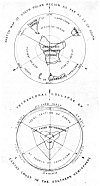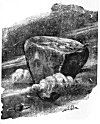
Sacred Texts Earth Mysteries Index Previous Next

THE LAST FIGURE OF EARTH in this collecting of its endlessly changing forms is, so far as I know, the latest figure of Earth to be drawn; it differs in all ways from any other world-picture we have here. Plate XLVIII is a drawing of the Earth as a Tetrahedron or three-sided pyramid; it appeared in the New York World, October 24, 1926, as an illustration to a review of Théophile Moreux's Astronomy To-day. It is not "scientific"; it is just an example of how a "guess" takes a form, even in this age. It has an interesting story, this figure of Earth; and so we begin, far enough back.
"Continents rise and sink as if through some gentle act of respiration. They move in long undulations which may be compared to waves of the sea."
This sounds as if some mild mystic were speaking, but it is Elisée Reclus, French geographer, writing of The Earth in 1870. Twenty years later Clarence Dutton, American

Click to enlarge
PLATE XLVII. (From Vestiges of the Molten Globe; William Lowthian Green, 1875)
geologist, coined a term, the Theory of Isostacy, for the fast developing theory of the floatation of the earth's crust, or floating continents. Less than ten years ago Alfred Wegener, in The Origin of Continents and Oceans, advanced this theory. The continents are masses of sial or "continental rock," moving through the sima--that rock forming the substratum of the ocean bed, which he compares in its viscosity to sealing wax; it is, that is, an extremely viscous fluid, offering a very great resistance to any change of form, but inevitably yielding, under constant pressure, to the passage of the continental masses. Very simply and fantastically imaged, it is as if the continents were enormous leaves or flowers or branches springing from some great parent stalk or trunk imbedded in the very earth of Earth, and floating upwards through the ocean depths to the watery surface and far beyond it.
And yet it is almost this very figure--the inverted pyramidal plant figure of the floating continents--which William Lowthian Green worked out in 1875 with the aid of a "model crystal," a tetrahedron with its sides depressed and its four corners thereby slightly raised. His hypothesis is that during the process of the Earth's cooling, and because of what he calls "the tetrahedral collapse of the Earth's crust in the southern hemisphere," the assumed spheroid form of the Earth (giving a minimum of surface for a given volume) tended to develop into a tetrahedron (giving a maximum of surface for a given volume), with the continents as the edges and the ocean beds as the sides. "Thus," says Green, 1 "a general view of the crystal, the six-
faced tetrahedron [Fig. 20], supposed to be three-fourths covered by water attracted towards the centre of gravity of the figure, represents generally all the continents and oceans on the globe in their actual relative positions. As there are four acute solid angles on the crystal, so there are four and only four continents or masses in relief on the globe, and as there are four obtuse angles on the crystal, so there are four and only four grand depressions or oceans on the globe."
Try to find any general reference to "Green's theory"; scientists knew of it, of course, but otherwise it is as if it appeared like a comet in the sky of 1875, not to appear again for over fifty years.
Moreux spoke of it, however, in his Astronomy To-day, and thanks to the way he spoke of it, we have this last picture of a tetrahedral Earth. He takes up one by one the unsolved problems of the Earth and the heavens, and it is an amazing array of the unknown. The dozen or so movements of the Earth is a puzzle; the irregularity of those movements is a puzzle, the Earth's real centre of gravity is a puzzle, the planetary system individually and as a whole is a puzzle, the "respiration" of the Earth is a puzzle, the Earth-Moon system would be the puzzle of puzzles if it were not for the fact that the still unknown actual figure of the Earth is the puzzle that tops them all. It is more of a problem to-day than it was in 1885.
For in 1885 that which was to solve it did no more than to tangle again all the laboriously disentangled threads. The discovery of invar in that year, an alloy of nickel and steel whose expansion and contraction at ordinary temperature
is almost nothing, seemed to make possible for the first time, at least in our recorded history, the accurate measuring of the supposed oblate spheroid on which we live. The invar wire was the unerring instrument by which scientists began again the painstaking re-measuring of the Earth. "At the present time," says Moreux, "the survey of the Earth has been carried out in all possible directions, and the results have made the problem only more puzzling. It is found that, even between the same latitudes, meridian arcs are not all of equal lengths, and dissymmetry is everywhere; it becomes more pronounced still when the two hemispheres are compared; and the equator itself, instead of being accurately a circle, like the largest circle of a spheroid, has different radii of curvature at different longitudes." 1
Since astronomers must, in all their practical calculations, make use of the mathematical elements of this globe so-called, they have, for themselves, determined on a set of average values not too far removed from the unknown real ones, which for the time serves them fairly well. But geographers and geologists, says Moreux, are not interested in this merely approximate solution of the enigma. "By considering the matter closely, they have found that certain systematic variations which occur in pendulum observations and in the value of gravity point more and more to the truth of an old theory which was long ignored. It was suggested by Green in 1875;" and then he re-states Green's hypothesis:
"According to this theory, the Earth would tend, in the
process of cooling, to take the form of a tetrahedron or triangular pyramid, with four faces and four corners or coigns. The seas would occupy the depressions and form the faces of the pyramid, while the continents would be situated round the coigns and would reach out along the edges.
"The facts seem to be in considerable agreement with this supposition. Three of the coigns are in the northern hemisphere; to use the picturesque expression of Suess, they are the Scandinavian, Canadian, and Siberian 'bucklers,' the last being situated near Yakutsk. Moreover, these projecting continents are of very ancient formation, and their ramifications extend more or less uninterruptedly as far as the South Pole. The opposite faces consist of the Southern Atlantic, the Indian and the Pacific Oceans. Lastly, the fourth corner forms the Antarctic continent, to which there corresponds, on the opposite face, the frozen Arctic Ocean." 1
These are the words that gave the image that produced this latest figure to be drawn of the Earth, a tetrahedron or three-sided pyramid, with four continents and four oceans, spinning in space. It is worth noting here that Green says of his "crystal model": "Crystallographers are aware that the six-faced tetrahedron with convex faces may geometrically as well as in nature and fact, approach to the form of a sphere, and that many diamonds possessing that crystalline figure are hardly distinguishable from spheres, but yet may be true six-faced tetrahedrons."
Without committing himself at all to the tetrahedral

Click to enlarge
PLATE XLVIII. THE TETRAHEDRAL EARTH
(From The Sunday Magazine, New York World, Oct. 24, 1926)
figure of Earth as established, Moreux adds that "the tetrahedral theory accounts for the inequality of the polar radii, and at the same time gives a more satisfactory explanation than any rival theory does of certain facts of astronomy which are inconsistent with the Earth's being a true ellipsoid of revolution." So, too, he says, the general plan of the Earth's relief and main lines of fractures or crumplings on its surface would, by this theory, be the logical consequence of the contracting process which began during the first of the geological eras and has continued according to the same laws ever since.
Be very sure that science to-day is committed to nothing but "guesses" on the still unknown figure of the Earth. We are doing to-day, in the last analysis, no more than that first man, whoever and wherever and whenever he was, who said, "Perhaps it is like this," and set down his crude lines of an island in a sea. We know a great many facts about a great many things, and a great many things about a great many facts; and this multitude of facts and things is just exactly our confusion. The facts are facts, but they are contradictory facts; they have not fused into the one great truth about the one Earth of which we know--a little. We have girdled the globe in ships on the surface of its waters, we have rounded the unknown line of its curve under its waters, and we are making our own curves through its air as we fly above it. But no man has ever seen the Earth. It is invisible. We talk of the secrets of the frozen North; they are no more than a handful of the secrets of the Earth. It lies over the Sun and under the Moon, giving everything, but forever withholding the
sum of everything--the right image of its own true, unimaginable form.
What is Earth?
A geoid.
What is a geoid?
An Earth-shaped body.
What is an Earth-shaped body?
A geoid.
What is Earth?
257:1 Vestiges of the Molten Globe; William Lowthian Green, 1875, p. 5.
259:1 Astronomy To-day; Théophile Moreux, 1926, p. 65. 259
260:1 Astronomy To-day; Théophile Moreux, 1926, p. 66.